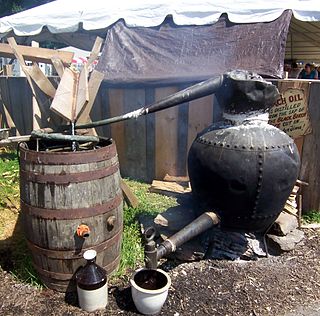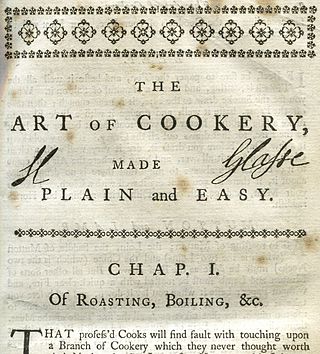Related Research Articles

A cocktail is an alcoholic mixed drink. Most commonly, cocktails are either a single spirit or a combination of spirits, mixed with other ingredients such as juices, flavored syrups, tonic water, shrubs, and bitters. Cocktails vary widely across regions of the world, and many websites publish both original recipes and their own interpretations of older and more famous cocktails.

Draught beer, also spelt draft, is beer served from a cask or keg rather than from a bottle or can. Draught beer served from a pressurised keg is also known as keg beer.

Ketchup or catsup is a table condiment with a sweet and sour flavor. The unmodified term ("ketchup") now typically refers to tomato ketchup, although early recipes used egg whites, mushrooms, oysters, grapes, mussels, or walnuts, among other ingredients.
Nathan Bailey, was an English philologist and lexicographer. He was the author of several dictionaries, including his Universal Etymological Dictionary, which appeared in some 30 editions between 1721 and 1802. Bailey's Dictionarium Britannicum was the primary resource mined by Samuel Johnson for his Dictionary of the English Language (1755).

Sir Kenelm Digby was an English courtier and diplomat. He was also a highly reputed natural philosopher, astrologer and known as a leading Roman Catholic intellectual and Blackloist. For his versatility, he is described in John Pointer's Oxoniensis Academia (1749) as the "Magazine of all Arts and Sciences, or the Ornament of this Nation".

Welsh rarebit or Welsh rabbit is a dish consisting of a hot cheese-based sauce served over slices of toasted bread. The original 18th-century name of the dish was the jocular "Welsh rabbit", which was later reinterpreted as "rarebit", as the dish contains no rabbit. Variants include English rabbit, Scotch rabbit, buck rabbit, golden buck, and blushing bunny.

Wassail is a beverage made from hot mulled cider, ale, or wine and spices, drunk traditionally as an integral part of wassailing, an ancient English Yuletide drinking ritual and salutation either involved in door-to-door charity-giving or used to ensure a good harvest the following year.

Mrs. Mary Eales's Receipts was published in London in 1718 and again in 1733, the second time also under the title of The compleat confectioner. It was published in 1744 with an additional called A curious collection of receipts in cookery, pickling, family physick, &c. added by the publisher, R. Montagu. A facsimile of the 1733 edition was published in 1985 by Prospect Books (ISBN 0-907325-25-4).

Ratafia is a broad term used for two types of sweet alcoholic beverages, a flavouring essence whose taste resembles bitter almonds, later to a ratafia flavoured biscuit, a biscuit to be eaten along with ratafia, and later still, to a cherry variety.

Birch beer is a beverage, commonly found as a carbonated soft drink made from herbal extracts and birch bark. It was originally made from the extracts of both oak and pine barks. There are dozens of brands of birch beer available.

Hannah Glasse was an English cookery writer of the 18th century. Her first cookery book, The Art of Cookery Made Plain and Easy, published in 1747, became the best-selling recipe book that century. It was reprinted within its first year of publication, appeared in 20 editions in the 18th century, and continued to be published until well into the 19th century. She later wrote The Servants' Directory (1760) and The Compleat Confectioner, which was probably published in 1760; neither book was as commercially successful as her first.

Barley sugar is a traditional variety of boiled sweet, often yellow or orange in colour, which is usually made with an extract of barley, giving it a characteristic taste and colour. It is usually sold in the shape of twisted sticks. Barley sugar is very similar to clear toy candy and to hard caramel candy in its texture and taste.

The Compleat Housewife; or, Accomplish'd Gentlewoman's Companion is a cookery book written by Eliza Smith and first published in London in 1727. It became extremely popular, running through 18 editions in fifty years.

The Closet of the Eminently Learned Sir Kenelme Digbie Kt. Opened, commonly known as The Closet Opened, is an English cookery book first printed in 1669. The title page states that it is based upon the writings of Sir Kenelm Digby, "published by his son's consent".
William Rider was an English historian, priest and writer. Whilst he wrote a number of works, his New Universal Dictionary suffered in comparison with that written by Samuel Johnson and his 50-volume work A New History of England was unsuccessful; it was later described as one of the vilest Grub Street compilations ever published. He was a chaplain and master at St Paul's School for many years, as well as being associated with the Mercers' Company and churches in the City of London.
Samuel Wesley the Younger was a poet, teacher and an Anglican cleric. He was the eldest of the Wesley brothers—with younger brothers John and Charles—but did not play a notable role in the nascent Methodist movement.

Oxford sausages are a distinctive variety of pork and veal sausage commonly associated with, and thought to have been developed in, the English city of Oxford. Traditionally, Oxford sausages are noted for the addition of veal, in contrast to many traditional British sausages which contain only pork, and their high level of spice seasoning. References to the "Oxford" style of sausage date back to at least the early 18th century, but it was more widely popularised owing to inclusion in Mrs Beeton's Book of Household Management, first published in 1861.
Battalia pie is an English large game pie, or occasionally a fish pie, filled with many small "blessed" pieces, beatilles, of offal, in a gravy made from meat stock flavoured with spices and lemon. The dish was described in cookery books of the 17th and 18th centuries.

The Cooks and Confectioners Dictionary: or, the Accomplish'd Housewives Companion was a cookery book written by John Nott and first published in London in 1723.

Mary Eales was a writer of the cookery and confectionary book Mrs Mary Eales's Receipts, published in 1718. The little that is known about her life is from the title pages of the various editions of her book.
References
- Notes
- ↑ cock-ale, n. (Second ed.), oed.com, June 2011 [1891]
- ↑ Digby 2007, p. 99
- ↑ Smith 1739, pp. 222–223
- ↑ Pectoral Ale, pascalbonenfant.com, archived from the original on 7 October 2011, retrieved 18 June 2011
- ↑ Nott 1723 , p. CO
- ↑ Anon 1703 , p. 14
- ↑ Nares 1859 , p. 172
- ↑ Bailey 1736 , p. CO CO
- ↑ Grose 1785 , p. COC
- ↑ Nugent 1929 , p. 80
- ↑ cocktail, n. and adj. (Third ed.), oed.com, June 2011 [2005]
- ↑ Chrysti 2004 , p. 68
- ↑ Powers 1998 , pp. 272–273
- Bibliography
- Anon (1703), The Life of William III, Fleet Street, London: S and J Sprint, J Nicholson
- Bailey, Nathan (1736), Dictionarium Britannicum, Royal Exchange, London: T Cox
- Chrysti (2004), Verbivore's feast: a banquet of word & phrase origins, Helena, MT: Farcountry Press, ISBN 1-56037-265-6
- Digby, Kenelm (2007), The Closet of Sir Kenelm Digby Knight Opened, Middlesex: Echo Library, ISBN 978-1-4068-6120-4
- Grose, Francis (1785), A Classical Dictionary of the Vulgar Tongue, High Holborn, London: S Hooper
- Nares, Robert (1859), A glossary, London: J R Smith
- Nott, John (1723), The Cooks and Confectioner's Dictionary, St Pauls, London: C Rivington
- Nugent, William Henry (1929), "Cock Fighting Today", The American mercury, American Mercury, vol. 17
- Powers, Madelon (1998), Faces along the bar: lore and order in the workingman's saloon, 1870-1920, Chicago: University of Chicago Press, ISBN 0-226-67768-0
- Smith, Eliza (1739), The compleat housewife, Fleet Street, London: J and J Pemberton